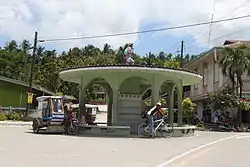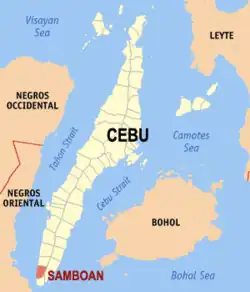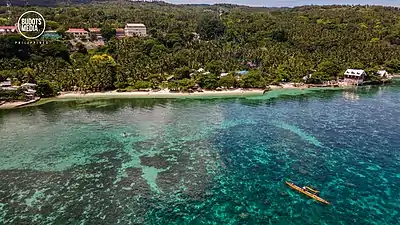Samboan
Samboan, officially the Municipality of Samboan (Cebuano: Lungsod sa Samboan; Tagalog: Bayan ng Samboan), is a 5th class municipality in the province of Cebu, Philippines. According to the 2020 census, it has a population of 20,373 people.[3]
Samboan
Canamucan | |
|---|---|
| Municipality of Samboan | |
 Rotunda, Samboan | |
 Seal | |
| Etymology: Sinamboangan | |
 Map of Cebu with Samboan highlighted | |
OpenStreetMap | |
.svg.png.webp) Samboan Location within the Philippines | |
| Coordinates: 9°31′44″N 123°18′23″E | |
| Country | Philippines |
| Region | Central Visayas |
| Province | Cebu |
| District | 2nd district |
| Founded | 1784 |
| Barangays | 15 (see Barangays) |
| Government | |
| • Type | Sangguniang Bayan |
| • Mayor | Emerito Emmanuel D. Calderon Jr. (1Cebu) |
| • Vice Mayor | Irving P. Gamallo (1Cebu) |
| • Representative | Edsel A. Galeos |
| • Municipal Council | Members |
| • Electorate | 13,984 voters (2022) |
| Area | |
| • Total | 45.16 km2 (17.44 sq mi) |
| Elevation | 156 m (512 ft) |
| Highest elevation | 693 m (2,274 ft) |
| Lowest elevation | 0 m (0 ft) |
| Population (2020 census)[3] | |
| • Total | 20,373 |
| • Density | 450/km2 (1,200/sq mi) |
| • Households | 4,862 |
| Economy | |
| • Income class | 5th municipal income class |
| • Poverty incidence | 21.60 |
| • Revenue | ₱ 119.8 million (2020) |
| • Assets | ₱ 374.4 million (2020) |
| • Expenditure | ₱ 83.19 million (2020) |
| • Liabilities | ₱ 42.61 million (2020) |
| Service provider | |
| • Electricity | Cebu 1 Electric Cooperative (CEBECO 1) |
| Time zone | UTC+8 (PST) |
| ZIP code | 6027 |
| PSGC | |
| IDD : area code | +63 (0)32 |
| Native languages | Cebuano Tagalog |
It is located 150 kilometres (93 mi) south of Cebu City.
Samboan is bordered to the north by the town of Ginatilan, to the west is the Tañon Strait, to the east is the town of Oslob, and to the south is the town of Santander.
History
Samboan is popularly known as an abbreviation of the word sinamboang as a form of fishing during the Spanish time.
However, Samboan in our historical papers is probably known to be Canamucan which is a territory under the Spanish encomienda system of the Spanish administration during their tenure and conquest. As time goes by, Canamucan becomes Samboan in the current usage.
Samboan is a small town on a hill. But it used to be a much bigger town, with Alegria under its territorial jurisdiction. In fact, the people of Alegria were made to render forced labor for the construction of the Samboan church. It was only sometime during the middle of the 1880s that those two towns were separated from Samboan (the towns of Ginatilan and Malabuyoc, which now lie in between, were created after the separation).
The municipality of Samboan is one of the emerging towns in the island of Cebu. It is one of the most resilient towns of the whole Philippines ranking 6th in the whole country per ranking under the competitive index of LGUs as of the year 2017. It is also a two-time awardee for the National Seal of Good Local Governance from year 2016 and 2017. It is also a known awardee for the Child-Friendly municipality in 2016 and continues to be so at present.
Geography
Barangays
Samboan is politically subdivided into 15 barangays. Each barangay consists of puroks and some have sitios.
| PSGC | Barangay | Population | ±% p.a. | |||
|---|---|---|---|---|---|---|
| 2020[3] | 2010[5] | |||||
| 072240001 | Basak | 5.2% | 1,064 | 1,027 | 0.35% | |
| 072240002 | Bonbon | 3.0% | 608 | 540 | 1.19% | |
| 072240003 | Bulangsuran | 5.5% | 1,121 | 1,099 | 0.20% | |
| 072240004 | Calatagan | 6.7% | 1,371 | 1,126 | 1.99% | |
| 072240005 | Cambigong | 3.8% | 782 | 670 | 1.56% | |
| 072240010 | Camburoy | 3.9% | 802 | 870 | −0.81% | |
| 072240006 | Canorong | 5.3% | 1,085 | 926 | 1.60% | |
| 072240007 | Colase | 5.3% | 1,086 | 968 | 1.16% | |
| 072240008 | Dalahikan | 6.8% | 1,379 | 1,185 | 1.53% | |
| 072240009 | Jumangpas | 7.4% | 1,517 | 1,400 | 0.81% | |
| 072240015 | Monteverde | 3.6% | 734 | 720 | 0.19% | |
| 072240011 | Poblacion | 19.3% | 3,928 | 3,901 | 0.07% | |
| 072240012 | San Sebastian (Bato) | 10.8% | 2,197 | 2,167 | 0.14% | |
| 072240013 | Suba | 9.6% | 1,948 | 952 | 7.42% | |
| 072240014 | Tangbo | 6.2% | 1,262 | 1,080 | 1.57% | |
| Total | 20,373 | 18,613 | 0.91% | |||
Climate
| Climate data for Samboan, Cebu | |||||||||||||
|---|---|---|---|---|---|---|---|---|---|---|---|---|---|
| Month | Jan | Feb | Mar | Apr | May | Jun | Jul | Aug | Sep | Oct | Nov | Dec | Year |
| Average high °C (°F) | 29 (84) |
29 (84) |
30 (86) |
32 (90) |
31 (88) |
30 (86) |
30 (86) |
30 (86) |
30 (86) |
29 (84) |
29 (84) |
29 (84) |
30 (86) |
| Average low °C (°F) | 23 (73) |
23 (73) |
23 (73) |
24 (75) |
25 (77) |
25 (77) |
24 (75) |
24 (75) |
24 (75) |
24 (75) |
24 (75) |
23 (73) |
24 (75) |
| Average precipitation mm (inches) | 35 (1.4) |
28 (1.1) |
38 (1.5) |
51 (2.0) |
125 (4.9) |
195 (7.7) |
194 (7.6) |
173 (6.8) |
180 (7.1) |
192 (7.6) |
121 (4.8) |
64 (2.5) |
1,396 (55) |
| Average rainy days | 9.2 | 8.2 | 9.9 | 11.3 | 22.5 | 27.3 | 28.0 | 27.2 | 27.1 | 26.9 | 19.7 | 12.7 | 230 |
| Source: Meteoblue[6] | |||||||||||||
Demographics

| Year | Pop. | ±% p.a. |
|---|---|---|
| 1903 | 9,870 | — |
| 1918 | 12,039 | +1.33% |
| 1939 | 11,062 | −0.40% |
| 1948 | 11,050 | −0.01% |
| 1960 | 11,065 | +0.01% |
| 1970 | 11,804 | +0.65% |
| 1975 | 13,586 | +2.86% |
| 1980 | 14,798 | +1.72% |
| 1990 | 15,005 | +0.14% |
| 1995 | 15,770 | +0.94% |
| 2000 | 16,659 | +1.18% |
| 2007 | 18,140 | +1.18% |
| 2010 | 18,613 | +0.94% |
| 2015 | 20,884 | +2.22% |
| 2020 | 20,373 | −0.49% |
| Source: Philippine Statistics Authority[7][5][8][9] | ||
Economy
Culture
Heritage buildings
One aspect of interest is that of Samboan's cultural heritage left by the Spanish conquerors.
St. Michael Archangel Church is one of the oldest Spanish-built churches in Cebu, made of coral stones. Today, it is a national protected heritage structure by the National Historical Commission. It has now a NHC permanent marker.
The Watch Tower is another Spanish structure, also made up of blocks of coral stones. It was built on the side of the hill to watch out for Moro invaders approaching the island. It is the tallest watch tower in the entire island of Cebu, and best preserved.
Connecting the beach area with the Spanish Watch Tower is St. Jacob's Ladder (Escala de Jacobe). It is a flight of 147 stone steps built in 1878, which leads to the old watchtower on a plateau 65 metres (213 ft) above the town. From here, one can get a view of the Tañon Strait.
The Museo de Samboan is the old municipal building of Samboan which now housed items of Samboan's way of life during our history up to the present. It was converted into a museum when the New Samboan Municipal Hall was erected.
The Samboan WWII Volunteers Monument, at the center of Poblacion on the National Highway, was built in honor of the many volunteers who fought for the freedom of the Philippines.
The San Sebastian Stone Walls are old stone structures near San Sebastian Parish Church. This may be why this barangay is popularly known as 'Bato' (meaning "stone").
The Spanish Boundary Post. It stands along the highway in Tangbo beside the Tangbo—Bonbon River Bridge. It was believed that it used to mark the boundary limit of old Poblacion but now merely serves to mark the boundary between Bonbon and Tangbo barangays.
Tourism
Natural attractions

Samboan is known for its beautiful crystal clear waters with a rich marine ecosystem along its coastal barangays.
Colase Marine Sanctuary is managed by the municipality together with a fisherfolks organization. Here one can visit the fish sanctuary or dive for a fee to experience the most preserved marine ecosystem where sharks, dolphins and whales in the shallowest part of the foreshore. Aside from Colase, other coastal barangays including San Sebastian (Bato), Dalahikan, Tangbo, Bonbon, Suba and Poblacion offer the same experience generally.
Aguinid Waterfalls in Tangbo comprises five different tiers along Tangbo river. Each tier has a unique waterfall. One can never reach the peak or last waterfall without climbing the limestone walls of each waterfall from the lowest to highest.
Bonbon Binalayan Hidden Falls to the immediate south of Poblacion which some visitors call the Triple Drop Falls.
Ponong Hidden Lake is a small enclosed lagoon with a brackish water. It is unique in the sense that here is where a certain kind of bird – the "manolong" – dives into its salty waters and stays under for a long time in order to escape hunters. Today, it is perfect for relaxation, bird watching, fish feeding and firefly watching.
Balay'g Sawa Falls has a waterfall located in the heart of Samboan covered with lush forest greens. It is along the river shared by Poblacion and Bonbon. It is home to protected species including bats and siloys not to mention some local plants and trees.
Mt. Bartolina situated in between Bulangsuran and Canang (Oslob) is where one can climb the peak and see both sides of Cebu, facing Bohol Strait to the east and Tañon Strait to the west. Bartolina is the highest peak in the south of Cebu where the panoramic view of north and south Bais Bay and the rest of Negros, Siquijor, and Bohol islands can be seen.
Dau Falls is the highest waterfall in Samboan.[17] It is located in Barangay Suba.
Tabon Falls is a recently developed natural spot found between Tangbo and Bonbon.
Town Fiesta
The town fiesta is celebrated each 29–30 September in honor of the patron saint, Michael (San Miguel, ang Arkanghel).
Delicacies
- Torta Especial (with or without coco wine) and Samboan cookies, which usually come out best during fiesta for visitors to try.
- Torta de Tangbo is said to be among the best in the locality.
- Manokhang is a native chicken cooked under coconut milk with hot pepper and "ulang" (Freshwater Shrimp).
- Linubihang Kagang is a common specialty in town from "kagang" (Land Crab) cooked with "tuno" (coconut milk).
- Tabanglang is a native dish made from sauteed "tabangka" (Snail) and "Ulang" (Freshwater Shrimp). It is a good appetizer.
- Coco Maize Pudding is locally known as "kalo-kalo" with coconut meat and corn flour (tiktik). It is a dessert served hot & cold.
Education
The public schools in the town of Samboan are administered by one school district under the Schools Division of Cebu Province.
Elementary schools:
- Basak Elementary School — Basak
- Cambigong Elementary School — Cambigong
- Cañorong Elementary School — Cañorong
- Colase Elementary School — Colase
- Dalahikan Elementary School — Dalahikan
- Jumangpas Elementary School — Jumangpas
- Kalatagan Elementary School — Calatagan
- Kamburoy Elementary School — Camburoy
- Manuel L. Quezon Elementary School — Poblacion
- Monteverde Elementary School — Monteverde
- Samboan Central Elementary School — Poblacion
- San Sebastian Elementary School — San Sebastian
- Suba Elementary School — Suba
- Tangbo Elementary School — Tangbo
High schools:
- Pedro B. Uy Calderon Memorial National High School — Jumangpas
- Samboan National High School — Poblacion
- San Sebastian National High School — San Sebastian
Integrated schools:
- Bulangsuran Integrated School — Bulangsuran
Private schools:
- St. Pius X School of Samboan, Inc. — Poblacion
References
- Municipality of Samboan | (DILG)
- "2015 Census of Population, Report No. 3 – Population, Land Area, and Population Density" (PDF). Philippine Statistics Authority. Quezon City, Philippines. August 2016. ISSN 0117-1453. Archived (PDF) from the original on May 25, 2021. Retrieved July 16, 2021.
- Census of Population (2020). "Region VII (Central Visayas)". Total Population by Province, City, Municipality and Barangay. Philippine Statistics Authority. Retrieved 8 July 2021.
- "PSA Releases the 2018 Municipal and City Level Poverty Estimates". Philippine Statistics Authority. 15 December 2021. Retrieved 22 January 2022.
- Census of Population and Housing (2010). "Region VII (Central Visayas)" (PDF). Total Population by Province, City, Municipality and Barangay. National Statistics Office. Retrieved 29 June 2016.
- "Samboan: Average Temperatures and Rainfall". Meteoblue. Retrieved 10 May 2020.
- Census of Population (2015). "Region VII (Central Visayas)". Total Population by Province, City, Municipality and Barangay. Philippine Statistics Authority. Retrieved 20 June 2016.
- Censuses of Population (1903–2007). "Region VII (Central Visayas)". Table 1. Population Enumerated in Various Censuses by Province/Highly Urbanized City: 1903 to 2007. National Statistics Office.
- "Province of Cebu". Municipality Population Data. Local Water Utilities Administration Research Division. Retrieved 17 December 2016.
- "Poverty incidence (PI):". Philippine Statistics Authority. Retrieved December 28, 2020.
- "Estimation of Local Poverty in the Philippines" (PDF). Philippine Statistics Authority. 29 November 2005.
- "2003 City and Municipal Level Poverty Estimates" (PDF). Philippine Statistics Authority. 23 March 2009.
- "City and Municipal Level Poverty Estimates; 2006 and 2009" (PDF). Philippine Statistics Authority. 3 August 2012.
- "2012 Municipal and City Level Poverty Estimates" (PDF). Philippine Statistics Authority. 31 May 2016.
- "Municipal and City Level Small Area Poverty Estimates; 2009, 2012 and 2015". Philippine Statistics Authority. 10 July 2019.
- "PSA Releases the 2018 Municipal and City Level Poverty Estimates". Philippine Statistics Authority. 15 December 2021. Retrieved 22 January 2022.
- Balais 2012.
Sources
- Balais, Harry (2012). "Chasing Waterfalls: Dau Falls". Archived from the original on 31 December 2014. Retrieved 26 August 2016.